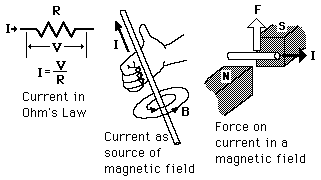Electric Charge
The unit of electric charge is the coulomb. Ordinary matter is made up of atoms which have positively charged nuclei and negatively charged electrons surrounding them. Charge is quantized as a multiple of the electron or proton charge:

The influence of charges is characterized in terms of the forces between them (Coulomb's law) and the electric field and voltage produced by them. One coulomb of charge is the charge which would flow through a 120 watt lightbulb (120 volts AC) in one second. Two charges of one coulomb
each separated by a meter would repel each other with a force of about a million tons!
The rate of flow of electric charge is called electric current and is measured in amperes.
In introducing one of the fundamental properties of matter, it is perhaps appropriate to point out that we use simplified sketches and constructs to introduce
concepts, and there is inevitably much more to the story. No significance
should be attached to the circles representing the proton and electron, in
the sense
of implying a relative size, or even that they are hard sphere
objects,
although that's a useful first construct. The most important
opening idea,
electrically, is that they have a property called "charge" which is
the same
size, but opposite in polarity for the proton and electron. The
proton has
1836 times the mass of the electron, but exactly the same size
charge, only
positive rather than negative. Even the terms "positive" and
"negative" are
arbitrary, but well-entrenched historical labels. The essential
implication
of that is that the proton and electron will strongly attract each
other, the historical archtype of the cliche "opposites attract".
Two
protons or two electrons would strongly repel each other. Once you
have
established those basic ideas about electricity, "like charges
repel and
unlike charges attract", then you have the foundation for
electricity and can build from there.
From the precise electrical neutrality of bulk matter as well as from detailed microscopic experiments, we know that the proton and electron have the same magnitude of charge. All charges observed in nature are multiples of these fundamental charges. Although the standard model of the proton depicts it as being made up of fractionally charged particles called quarks, those fractional charges are not observed in isolation -- always in combinations which produce +/- the electron charge.
An isolated single charge can be called an "electric monopole". Equal positive and negative charges placed close to each other constitute an electric dipole. Two oppositely directed dipoles close to each other are called an electric quadrupole. You can continue this process to any number of poles, but dipoles and quadrupoles are mentioned here because they find significant application in physical phenomena.
One of the fundamental symmetries of nature is the conservation of electric charge. No known physical process produces a net change in electric charge.
|

